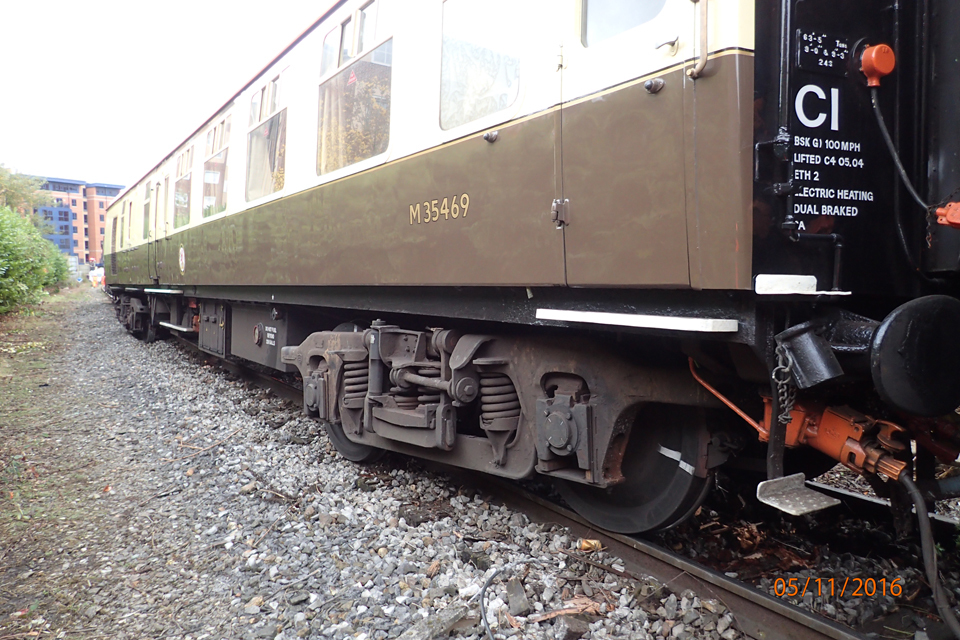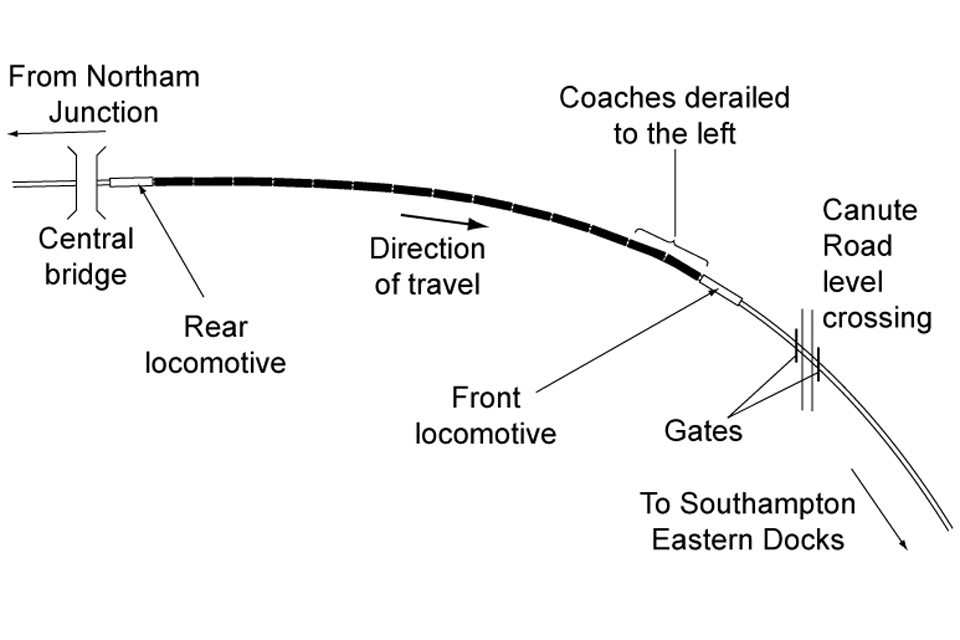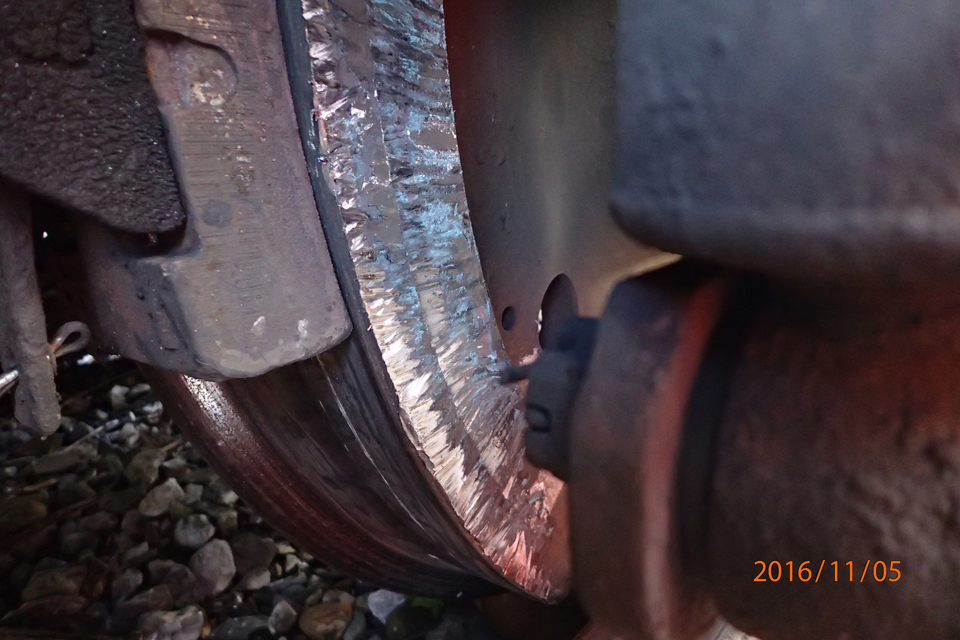Charter train derailment near Southampton Eastern Docks, 5 November 2016
Published 23 February 2017
1. Important safety messages
This accident illustrates the importance of:
- Supervisors reviewing patrollers’ concerns and acting upon them appropriately
- Identifying whether work requests have been received and actioned by the Route Asset Management team
- Identifying when inspection arrangements for particular areas have been omitted from Ellipse (Network Rail’s work database and asset management system) and taking appropriate action to reinstate them immediately when identified
- Providing appropriate cover for vacant posts to ensure workload does not become excessive and the safety of the railway is not put at risk
- Not re-prioritising (deferring) maintenance work unless the people involved have a good knowledge of the work required and the reasons for it, so that the safety of the railway is assured

The leading brown and cream coach showing three derailed axles.
2. Summary of the accident
On Saturday 5 November 2016 at 10:17 hrs a passenger charter train from London Waterloo to Fawley via Southampton Eastern Docks became derailed while travelling at 10 mph (16 km/h) on the single line between Northam Junction and Southampton Eastern Docks. The train came to a stop short of Canute Road level crossing. The train comprised class 66 diesel locomotives at both ends, and 13 coaches. There were 561 passengers on board. The service was operated by DB Cargo, which owned the locomotives and employed the driver and guard. The coaches were owned by Riviera Trains.
The first three axles of the leading coach and the first axle of the second coach derailed to the left on a right-hand curve. The passengers in the leading two coaches were transferred to the rear 11 coaches, which were uncoupled and, following examination, were taken to Eastleigh hauled by the rear locomotive.

A black and white line diagram showing the location of accident and the deraied coaches
3. Cause of the accident
The train derailed on track which was wide to gauge (the RAIB measured the gauge at up to 51 mm wider than the nominal standard gauge of 1435 mm on site under loaded conditions). The derailed wheels dropped between the rails, and as the train moved forward, the gauge narrowed, forcing the left-hand wheels (in the direction of travel) up and over the left-hand rail. There was significant bruising on the outside (field) face of the right-hand wheels, showing that they had run pressed hard up against the rail for some distance. Many of the sleepers were badly damaged in the derailment, but several sleepers appeared to have been defective and the rail fastenings were worn.

Significant bruising on the field face of the right-hand derailed wheels. The metal is ground away from the edge of the wheel.
The leading coach had newly re-profiled tyres. Examination of the wheels by Riviera Trains’ Technical Standards Engineer and Arlington Fleet Services Ltd confirmed that the wheel profiles on the coaches were in accordance with relevant standards, and that there was nothing about the condition of the coaches that might have led to the derailment.
This section of line is a branch which carries up to five train movements a day. Most of the traffic over the line is freight, carrying cars to and from Southampton Eastern Docks, with occasional passenger charter trains to and from the docks. Network Rail placed it in category 5 for maintenance purposes (where the track category is based on the speed and amount of traffic over a line, with 1 being the highest and 6 the lowest track category).
The inspection regime laid down in Network Rail company standard NR/L2/TRK/001/mod02, issue 7, ‘Track inspection’ requires track of this category to be subject to a basic visual inspection (a patrol), every two weeks; a section manager inspection every 13 weeks; and an inspection by the Track Maintenance Engineer (TME) every two years.
The TME’s inspections were carried out in accordance with the standards. However, due to an oversight, the regular patrols were being undertaken at four-weekly intervals, rather than fortnightly as required. This long standing non-compliance with the standards had not been detected by the local management team. At the time of the accident, the 13-weekly supervisory walks on this section of line had not been undertaken for at least 3 years because the requirement for this was not listed in Ellipse, and because of this the fact that these inspections were not being done was not highlighted to the responsible managers.
The Eastleigh track maintenance area has been without a track section manager for two years. Network Rail reports that during this period, and for up to three years previously, the section manager’s inspections in the area covered by the depot were completed by one of the assistant section managers, with permission from the route asset manager (track), but as noted above, the Southampton Eastern Docks branch was not covered. Some of the assistant section managers have covered the section manager role for a short time, but witness evidence indicates that the workload involved in doing this has led to increased sickness and a refusal to cover higher grade roles.
In early 2015 Network Rail decided to defer the renewal of the track in the area, which had been scheduled for autumn 2015. On 25 November 2015 an additional inspection by the TME was carried out to assess what works were required to keep the railway safe until the renewal works could be done. The report from the TME’s assessment was sent to the Route asset management team, but the RAIB has not been able to identify any resulting action taken at the location of the derailment.
Two work orders listed in Ellipse to replace decayed wooden sleepers close to the derailment site have been re-prioritised (deferred) on several occasions, the latest being 12 May 2016. The first report of replacement sleepers being required for the area near the derailment site was entered into the work bank in February 2012. This type of work is normally put down for completion within twelve months. The re-sleepering was later re-prioritised to 4 May 2017. Another work order for the same area, covering the derailment site, having previously been re-prioritised twice, was raised again by the TME inspection in March 2014 and re-prioritised to 10 May 2017, by someone acting on behalf of the section manager due to the long term vacancy. Contrary to Network Rail standard NR/L3/MTC/MG0176/02 issue 4, ‘Ellipse work management handbook’, this was done without a site visit by a supervisor to the defective area, and without reference to the TME.
The track patrols on the 9 August, 6 September and 4 October 2016 all highlighted that there were defective sleepers in the area of the derailment. These reports were logged and the information entered into Ellipse. Defects logged in this manner require rectifying within 4 weeks. No remedial work was recorded as having been undertaken and at the time of the accident no evidence of any works could be seen on the track, but the patroller’s log for the inspection carried out on 1 November did not report the defect.
In the last few years, some partial re-sleepering had been done, but by replacing individual sleepers without any attempt to correct the wide gauge. Only some of the re-sleepering work required in the area had been carried out. Due to incomplete records it is not possible to establish when this work was done or by whom.
4. Previous similar occurrences
About 4 miles south west of Gloucester station, a freight train derailed on 15 October 2013 (RAIB report 20/2014). The RAIB observed that, due to vacancies and long term illness, the local track maintenance team found it difficult to react to unplanned increases in workload.
Since the Gloucester investigation had identified a number of previous RAIB investigation reports in which staffing levels had featured, the RAIB wrote to Network Rail in September 2014 drawing attention to the high workloads associated with unfilled vacancies.
A freight train derailed just after passing Heworth station, near Newcastle, on 23 October 2014 (RAIB report 16/2015). An underlying cause was that the local track maintenance team was unable to cope with the volume of work it had to do, for a number of reasons including reduced numbers of track maintenance staff over a long period of time. Network Rail’s audit and self-assurance processes had not alerted senior management to the extent of non-compliances to maintenance processes, or triggered earlier action to resolve persistent problems affecting track assets in the local track maintenance team’s area.
Following the investigation into the Heworth derailment, the RAIB made two recommendations to Network Rail that are relevant to the accident in Southampton. These covered the need for Network Rail to review whether defects found by the track inspection regime are accurately recorded and corresponding repair work planned; and understanding and taking action to address why management arrangements allowed the non-compliances to processes found by the investigation to go undetected.
A charter service derailed on approach to the buffer stops at the terminus at Windsor and Eton Riverside station on 11 October 2009 (RAIB report 11/2010) because the track was unable to maintain the correct gauge as the train passed over. The RAIB recommended that Network Rail should develop a proposal for the periodic measurement of dynamic gauge at potentially vulnerable locations not covered by a track recording vehicle, and implement the identified measures. The line to Southampton Eastern Docks is not traversed by a track recording vehicle. If it had been, the person reprioritising works might have had more data on which to base their decision.
Concerns about repeated re-prioritising of maintenance and renewal work, and inadequate staffing levels, also featured in the RAIB’s report into the derailment at Epsom on 12 September 2006 (RAIB report 34/2007).
The RAIB’s investigation of an incident at Shawford on 24 June 2016, where a track worker was nearly struck by a train, is nearing completion. The investigation has found that a possible underlying factor (among others) was that the local rail testing and lubrication team was not resilient to any loss of resources or sudden increase in workload. This team is also based at Eastleigh depot.
As a result of this accident, the incident at Shawford and other recent RAIB investigations, the RAIB has again written to Network Rail on the subject of staffing levels.
You can print this safety digest.

